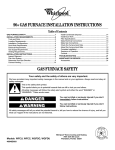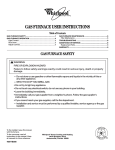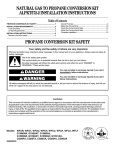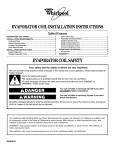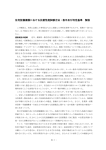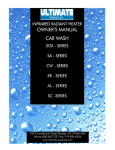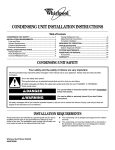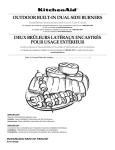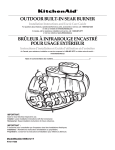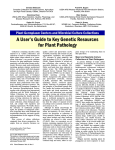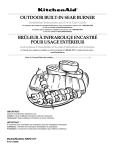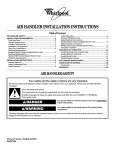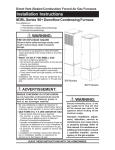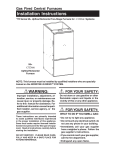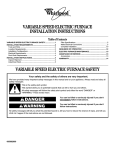Download Whirlpool WGFDU Specifications
Transcript
90+ GAS FURNACE INSTALLATION INSTRUCTIONS Table of Contents GAS FURNACE SAFETY................................................................1 INSTALLATION REQUIREMENTS ................................................3 Tools and Parts ............................................................................3 Location Requirements ................................................................4 Installation Configurations ...........................................................5 Ductwork Requirements ..............................................................5 Electrical Requirements ...............................................................6 Gas Supply Requirements ...........................................................6 Venting Requirements..................................................................6 INSTALLATION INSTRUCTIONS ..................................................8 Inspect Shipment .........................................................................8 Plan Vent System .........................................................................8 Determine Vent Pipe Direction...................................................10 Install Ductwork..........................................................................17 Filter Specifications....................................................................17 Make Electrical Connections .....................................................18 Make Gas Connections..............................................................19 Check the Furnace Input Rate (if required) ................................20 Adjust the Furnace Input Rate (if required) ................................20 Complete Installation..................................................................21 Shut Down..................................................................................21 SEQUENCE OF OPERATION ......................................................22 Heating Cycle .............................................................................22 Fan On Cycle..............................................................................22 Cooling Cycle .............................................................................22 CONTROLS ...................................................................................23 TROUBLESHOOTING ..................................................................24 ASSISTANCE OR SERVICE .........................................................27 Accessories ................................................................................27 GAS FURNACE SAFETY Your safety and the safety of others are very important. We have provided many important safety messages in this manual and on your appliance. Always read and obey all safety messages. This is the safety alert symbol. This symbol alerts you to potential hazards that can kill or hurt you and others. All safety messages will follow the safety alert symbol and either the word “DANGER” or “WARNING.” These words mean: DANGER WARNING You can be killed or seriously injured if you don't immediately follow instructions. You can be killed or seriously injured if you don't follow instructions. All safety messages will tell you what the potential hazard is, tell you how to reduce the chance of injury, and tell you what can happen if the instructions are not followed. Whirlpool® and Whirlpool Gold® Models WFCU, WFCC, WGFDC, WGFDU 46948B008 Whirlpool® Home Cooling and Heating 14610 Breakers Drive Jacksonville, FL 32258 IMPORTANT SAFETY INSTRUCTIONS ■ ■ ■ ■ ■ ■ ■ Use only with type of gas approved for this furnace. Refer to the furnace rating plate. Install this furnace only in a location and position as specified in the “Location Requirements” section of these instructions. ■ Provide adequate combustion and ventilation air to the furnace space as specified in the “Venting Requirements” section of these instructions. When a furnace is installed so that supply ducts carry air circulated by the furnace to areas outside the space containing the furnace, the return air shall also be handled by duct(s) sealed to the furnace casing and terminating outside the space containing the furnace. ■ Combustion products must be discharged outdoors. Connect this furnace to an approved vent system only, as specified in the “Venting Requirements” section of these instructions. ■ A gas-fired furnace for installation in a residential garage must be installed as specified in the “Location Requirements” section of these instructions. The furnace is not to be used for temporary heating of buildings or structures under construction. Never test for gas leaks with an open flame. Use a commercially available soap solution made specifically for the detection of leaks to check all connections, as specified in the “Make Gas Connections” section of these instructions. Adequate clearance must be provided around the vent-air intake terminals. Always install furnace to operate within the furnace’s intended temperature-rise range with a duct system which has an external static pressure within the allowable range, as specified in the “Complete Installation” section of these instructions. See furnace rating plate. ■ The furnace shall be installed so the electrical components are protected from water. ■ Furnaces for indoor installation on combustible flooring shall not be installed directly on carpeting, tile or other combustible material other than wood flooring. SAVE THESE INSTRUCTIONS WARNING: FIRE OR EXPLOSION HAZARD Failure to follow safety warnings exactly could result in serious injury, death or property damage. — Do not store or use gasoline or other flammable vapors and liquids in the vicinity of this or any other appliance. — WHAT TO DO IF YOU SMELL GAS • Do not try to light any appliance. • Do not touch any electrical switch; do not use any phone in your building. • Leave the building immediately. • Immediately call your gas supplier from a neighbor’s phone. Follow the gas supplier’s instructions. • If you cannot reach your gas supplier, call the fire department. — Installation and service must be performed by a qualified installer, service agency or the gas supplier. 2 WARNING: Gas leaks cannot always be detected by smell. Gas suppliers recommend that you use a gas detector approved by UL or CSA. For more information, contact your gas supplier. If a gas leak is detected, follow the “What to do if you smell gas” instructions. The California Safe Drinking Water and Toxic Enforcement Act requires the Governor of California to publish a list of substances known to the State of California to cause cancer, birth defects, or other reproductive harm, and requires businesses to warn of potential exposure to such substances. WARNING: This product contains a chemical known to the State of California to cause cancer, birth defects, or other reproductive harm. This appliance can cause low-level exposure to some of the substances listed, including benzene, formaldehyde, carbon monoxide, toluene, and soot. ADDITIONAL SAFETY INFORMATION In the State of Massachusetts, the following installation instructions apply: ■ ■ ■ Installations and repairs must be performed by a qualified or licensed contractor, plumber, or gasfitter qualified or licensed by the State of Massachusetts. If using a ball valve, it shall be a T-handle type. A flexible gas connector, when used, must not exceed 3 feet. INSTALLATION REQUIREMENTS These instructions are intended as a general guide only for use by qualified persons and do not supersede any national or local codes in any way. Compliance with all local, state, or national codes pertaining to this type of equipment should be determined prior to installation. Read this entire instruction manual, as well as the instructions supplied in separate equipment, before starting the installation. The installation of the furnace, wiring, warm air ducts, venting, etc. must conform to the requirements of the National Fire Protection Association; the National Fuel Gas Code, ANSI Z223.1/NFPA No. 54 (latest edition) and the National Electrical Code, ANSI/NFPA No. 70 (latest edition) in the United States, and any state laws, local ordinances (including plumbing or wastewater codes), or local gas utility requirements. Local authorities having jurisdiction should be consulted before installation is made. Such applicable regulations or requirements take precedence over the general instructions in this manual. This furnace design is certified by CSA International as a Category IV furnace in compliance with the latest edition of American National Standard Z21.47/CSA Standard 2.3 for GasFired Central Furnaces, for operation with Natural gas or propane. Consult the rating plate on the furnace for gas type before installing. Tools and Parts Gather the required tools before starting installation. Read and follow the instructions provided with any tools listed here. Tools needed ■ ■ ■ ■ ■ Pipe wrench Screwdriver Tape measure Thread sealant Level ■ ■ ■ Noncorrosive leak check solution Test gauge with ¹⁄₈" (3.2 mm) NPT connection (for measuring gas supply pressure) Allen wrench Parts needed Check local codes and with gas supplier. Check existing gas supply, electrical supply, and venting, and read “Ductwork Requirements,” “Electrical Requirements,” “Gas Supply Requirements,” “Venting Requirements” and “Installation Configurations” before purchasing parts. Parts supplied ■ ■ ■ Inlet air restrictor plate Flue pipe screen Condensate disposal kit 3 Location Requirements WARNING ■ All models are suitable for closet or utility room installation. Utility room installation requires: A door opening large enough for the widest part of the furnace. A door opening large enough to remove/replace any other appliance located in the utility room, such as a water heater. Any other appliances arranged so that each appliance can be removed/replaced without disturbing the furnace. Explosion Hazard ■ Keep flammable materials and vapors, such as gasoline, away from furnace. Place furnace so that burners are at least 18 inches (46 cm) above the floor for a garage installation. ■ Failure to follow these instructions can result in death, explosion, or fire. Installation Clearances ■ WARNING In a residential garage, a gas-fired furnace must be installed so the burner(s) and the ignition source are located not less than 18" (45.7 cm) above the floor. The furnace is to be located or protected to avoid physical damage by vehicles. If the furnace is to be installed in an attic or other insulated space, it must be kept free and clear of insulating materials. ■ A 2" (5.1 cm) minimum clearance is required in front for air openings into the combustion chamber. All servicing and cleaning of the furnace can be performed from the front. If the furnace is installed in a closet or utility room, provide 24" (61 cm) clearance in front for service if the door to the room is not in line with the front of the furnace. Where servicing clearances are greater than clearances to combustibles, servicing clearances take precedence. Minimum Clearance to Combustibles Chart Explosion Hazard Do not install this furnace in a mobile home. Doing so can result in death, explosion, fire, or carbon monoxide poisoning. IMPORTANT: Do not use the furnace as a heater in a building under construction. The furnace can be severely damaged due to the abnormal environment caused by construction. Chlorides from sources such as paint, stain, or varnish; tile and counter cements; adhesives; and foam insulation are abundant in a structure under construction and can be highly corrosive. Low return air temperature can cause condensation in the furnace and other damage that can shorten the life of the furnace. ■ The condensate drain on this furnace is incorporated within the furnace and must be primed before start-up. The condensate system must not be exposed to temperatures under 32°F (0ºC). ■ The furnace is suitable for installation in buildings constructed on site. The furnace should be centralized in respect to the heat distribution system as much as practicable. 4 Unit Sides 0" Rear of Unit 0" Front of Unit 2" (5.1 cm) Flue Pipe 0" Plenum Top (upflow) 1" (2.5 cm) Supply Duct (counterflow) 1"(2.5 cm) High Altitude Installations This furnace is approved for operation at altitudes from 0 to 4,500 ft (0 to 1,371.6 m) above sea level without any required modifications. ■ From 4,500 to 7,500 ft (1,371.6 m to 2,286 m), the gas manifold pressure needs to be adjusted according to the information shown in the Manifold Pressure vs. Altitude Chart in the “Adjust the Furnace Input Rate” section. IMPORTANT: For installations above 7,500 ft (2,286 m), the furnace input rate is to be reduced per the requirements of the National Fuel Gas Code (ANSI Z223.1/NFPA 54, latest edition), at the rate of 4 percent for each 1,000 ft (304.8 m) above sea level. The furnace is not recommended for installation above 10,000 ft (3,048 m). ■ Installation Configurations WGFDU and WFCU models must be installed only as upflow furnaces. WGFDC and WFCC models must be installed only as counterflow (downflow) furnaces. IMPORTANT: To ensure access to parts for servicing, install upflow and counterflow furnaces so that the burner and blower access panels are readily accessible. Upflow Installations Furnaces can be installed with either a side or bottom air return. For bottom air return the bottom air return knockout plate must be removed. For furnaces that do not include a side or bottom return filter rack, kit no. AFILT524-1 (side return) or kit no. AFILT529-1 (bottom return) can be used. To provide sufficient filter area for installations requiring more than 1,600 CFM nominal air delivery, return air will have to be brought through both sides of the furnace, or through one side and the bottom. 1. Cut a hole in the floor, sized to provide 1" (2.5 cm) clearance between all 4 sides of the duct and the edge of the flooring. The 4 angles on the base assembly should be recessed into the floor joists, and the base should rest on all 4 outside flanges. 2. Construct duct connections with 1" to 1³⁄₄" (2.5 cm to 4.4 cm) right angle flanges, and long enough to extend below the floor joists. 3. Drop the duct connections through the top of the base assembly with the right angle flanges in good contact with the glass tape on top of the base assembly. 4. Position the furnace over the right angle duct flanges. Combustible Floor Installation (Counterflow Models only) B B A Installation for Counterflow (Downflow) Models E D WARNING C 1" C Fire Hazard Before installing counterflow (downflow) furnace on combustible surface, such as wood, install one of the following kits: E WABASE 511 (14.5" cabinets) WABASE 512 (17.5" cabinets) WABASE 568 (21" cabinets) WABASE 569 (24.5" cabinets) A Contact your local dealer. A. Base assembly B. Furnace C. Outlet duct (drops into base assembly) Failure to do so can result in death or fire. IMPORTANT: ■ The furnace may be installed directly on the supply plenum or coil cabinet if the furnace is installed on a noncombustible floor. ■ For installations on combustible flooring, a special base must be ordered and used. See the “Accessories” section. D. Combustible floor E. Woven glass tape (between flanges of outlet duct and base assembly) Filters If a filter other than the one supplied by the furnace manufacturer is used, see Minimum Filter Requirements in “Filter Specifications.” Ductwork Requirements ■ ■ Install all conditioned air plenums, ducts and air filters (if not provided on the furnace) in accordance with NFPA 90B Standard for the Installation of Warm Air Heating and AirConditioning Systems (latest edition). The furnace is provided with flanges for the connection of the plenum and ducts. ■ ■ All air filters must be listed as Class 2 furnace air filters. All ductwork must be made of materials and insulated to meet local, state and national codes. Ductwork installed outdoors must be sealed, weatherproofed and protected against physical damage. Caulking, flashing or other means of adequately providing a permanent weather seal should be used where duct penetrates a building or structure opening. 5 Electrical Requirements WARNING Existing Venting Systems When an existing furnace is removed or replaced, the original venting system may no longer be sized to properly vent the attached appliances. An improperly sized venting system can result in the spilling of flue products into the living space, the formation of condensate, leakage, etc. See the “Carbon Monoxide Poisoning Hazard” for proper test procedure. WARNING: Electrical Shock Hazard Electrically ground furnace. Connect ground wire to green ground screw. Failure to do so can result in death or electrical shock. ■ ■ ■ ■ The furnace must be grounded and wired in accordance with local codes or, in the absence of local codes, with the National Electrical Code ANSI/NFPA No. 70 (latest edition). In all instances, other than wiring for the thermostat, the wiring to be done and any replacement of wire shall conform with the temperature limitation for Type T wire (63°F [17.2ºC] rise). The line voltage supply should be routed through a readily accessible disconnect located within sight of the furnace. A junction box on the furnace side panel is provided for line voltage connections. See the Wiring Connection Diagram in the “Troubleshooting” section for specific connection information. Proper polarity of the supply connections (“HOT” and “NEUTRAL”) must be observed to be sure that the control system provides the protection intended. Gas Supply Requirements This furnace is equipped for use with Natural gas. A conversion kit is required for use with propane. To order the correct conversion kit, see “Accessories.” ■ Gas supply piping should be installed in accordance with local, state and national codes and the regulations of the utility. Piping must be of adequate size to avoid undue pressure drop. Consult the local utility or gas supplier for complete details on special requirements for sizing gas piping. ■ If local codes allow the use of a flexible gas appliance connector, use a CSA design-certified outdoor flexible stainless steel appliance connector or rigid gas supply line as needed. Do not use a connector which has previously serviced another gas appliance. Venting Requirements Adequate provisions for combustion air and ventilation of furnace must be made. Refer to Section 5.3, “Air for Combustion and Ventilation,” of the National Fuel Gas Code, ANSI Z223.1/NFPA 54 (latest edition), or applicable provisions of the local building codes. 6 CARBON MONOXIDE POISONING HAZARD Failure to follow the steps outlined below for each appliance connected to the venting system being placed into operation could result in carbon monoxide poisoning or death. The following steps shall be followed for each appliance connected to the venting system being placed into operation, while all other appliances connected to the venting system are not in operation: 1. Seal any unused openings in the venting system. 2. Inspect the venting system for proper size and horizontal pitch, as required in the National Fuel Gas Code, ANSI Z223.1/NFPA 54 or the CSA B149.1, Natural Gas and Propane Installation Codes and these instructions. Determine that there is no blockage or restriction, leakage, corrosion and other deficiencies which could cause an unsafe condition. 3. As far as practical, close all building doors and windows and all doors between the space in which the appliance(s) connected to the venting system are located and other spaces of the building. 4. Close fireplace dampers. 5. Turn on clothes dryers and any appliance not connected to the venting system. Turn on any exhaust fans, such as range hoods and bathroom exhausts, so they are operating at maximum speed. Do not operate a summer exhaust fan. 6. Follow the lighting instructions. Place the appliance being inspected into operation. Adjust the thermostat so appliance is operating continuously. 7. Test for spillage from draft hood equipped appliances at the draft hood relief opening after 5 minutes of main burner operation. Use the flame of a match or candle. 8. If improper venting is observed during any of the above tests, the venting system must be corrected in accordance with the National Fuel Gas Code, ANSI Z223.1/NFPA 54 and/or CSA B149.1, Natural Gas and Propane Installation Codes. 9. After it has been determined that each appliance connected to the venting system properly vents when tested as outlined above, return doors, windows, exhaust fans, fireplace dampers and any other gas-fired burning appliances to their previous conditions of use. Venting Options The furnace can be installed as either direct vent or nondirect vent units. For either type of installation, special venting considerations must be followed. See “Determine Vent Pipe Direction” for the type of furnace and venting being installed. Direct Vent A direct vent (two pipe) installation requires that all the air necessary for combustion be supplied from outside the dwelling through an air intake pipe. When a furnace is installed in an unconfined space in a building, it can be assumed that the infiltration will be sufficient to supply the required air. If the furnace is installed in a ventilated attic or crawl space, it is assumed that the air infiltration is sufficient to supply the required combustion air. However, in a building of unusually tight construction, additional outdoor air should be provided. Confined Space A confined space is defined as “a space whose volume is less than 50 cu. ft (1.4 m3) per 1,000 Btu/h of the combined input rating of all appliances installed in that space.” Use direct vent method. See “Plan Vent System.” Nondirect Vent A nondirect vent (one pipe) installation uses air from inside the dwelling for combustion. ■ The furnace is shipped with the air inlet pipe terminated to the top panel for either inside or outside combustion air. An inlet air restrictor plate is supplied with this furnace and can be found in the plastic bag containing these Installation Instructions and the User’s Information Manual. ■ For installations using inside air for combustion (nondirect vent), attach a 90° elbow (not supplied) to the inlet coupler and install the restrictor plate inside the elbow. See “Nondirect Vent Installation.” Inlet Air Restrictor Plate IMPORTANT: The inlet air restrictor plate must be installed in all nondirect vent systems. Contaminated Combustion Air Excessive exposure to contaminated combustion air will result in performance related problems. The recommended source of combustion air is outdoor air. Outdoor air as the source of combustion air If the furnace is installed in a confined space, it is recommended that the necessary combustion air come from the outdoors by way of an attic, crawl space, air duct, or direct opening. Outdoor air is required as the source of combustion air when the indoor air is contaminated with chemical substances and in the following types of installations: ■ Furnaces installed in commercial buildings ■ Furnaces installed in buildings with indoor pools ■ Furnaces installed in hobby or craft rooms ■ Furnaces installed near chemical storage areas ■ Furnaces installed in laundry rooms ■ Furnaces installed in hair salons Indoor air as the source of combustion air Flue Pipe Screen A flue pipe screen designed to keep objects out of the flue pipe is included in the plastic bag. In all installations, this screen should be installed at the termination of the flue pipe. Flue Pipe Screen IMPORTANT: The flue pipe screen should be installed at the termination of the flue pipe in all installations. Indoor air as the source of combustion air is acceptable in most applications if the following guidelines are met: ■ All provisions for indoor combustion air must meet the requirements for combustion air indicated in the National Fuel Gas Code, ANSI Z223.1/NFPA 54 (latest edition), and/or any applicable local codes. ■ If indoor combustion air is used, the air supply to the furnace should not be exposed to the following substances: Permanent wave solutions Chlorinated waxes and cleaners Chlorine-based swimming pool chemicals Water softening chemicals Deicing salts or chemicals Carbon tetrachloride Halogen-type refrigerants Cleaning solvents (such as perchloroethylene) Unconfined Space Printing inks, paint removers, varnishes, etc. Cements and glues An unconfined space is defined as “a space whose volume is more than 50 cu. ft (1.4 m3) per 1,000 Btu/h of the combined input rating of all appliances installed in that space.” Antistatic fabric softeners for clothes dryers Masonry acid washing materials Chlorinated laundry products Hydrochloric acid 7 INSTALLATION INSTRUCTIONS WARNING Explosion Hazard Furnace must be installed and serviced by a qualified person. Examples of a qualified person include: IMPORTANT: ■ The venting system must be supported with mounting straps to keep any weight load from being applied to the vent blower. Horizontal vent pipe must be supported every 5 ft and vertical pipe should be supported every 10 ft to avoid sagging and provide rigid support. ■ This furnace must not be connected to any Type B, BW, or L vent or vent connector and must not be connected to any portion of a factory-built or masonry chimney. ■ This furnace is not to be common vented with any other appliance. The vent pipe must not be connected to a chimney flue serving a separate appliance designed to burn solid fuel. licensed heating personnel, authorized gas company personnel. Read and follow all instructions provided for installation, adjustment, service, alteration, or maintenance. Materials ■ Failure to follow these instructions can result in death, explosion, fire, or carbon monoxide poisoning. Inspect Shipment WARNING Excessive Weight Hazard Use two or more people to move and install furnace. Failure to do so can result in back or other injury. This furnace is shipped in one package, completely assembled and wired. The indoor thermostat and accessories are shipped in a separate carton when ordered. 1. Check the furnace rating plate to confirm specifications are as ordered. 2. Upon receipt of the furnace, inspect it for possible shipping damage. Examine the furnace inside the carton if the carton is damaged. If damage is found, it should be noted on the carrier’s freight bill. Damage claims should be filed with the carrier immediately. Claims of shortages should be filed with the seller within 5 days. NOTE: If any damages are discovered and reported to the carrier, do not install the furnace, because your claim may be denied. Piping and Fitting Specifications Piping and Fitting Material ASTM Specification Schedule 40 PVC (Pipe) D1785 Schedule 40 PVC (Cellular Core Pipe) F891 Schedule 40 PVC (Fittings) D2466 SDR-26 (Pipe) D2241 Schedule 40 ABS (Pipe) D1527 Schedule 40 ABS (Fittings) D2468 Schedule 40 & 80 CPVC (Pipe) F441 ABS-DWV Drain Waste & Vent (Pipe & Fittings) D2661 PVC-DWV Drain Waste & Vent (Pipe & Fittings) D2665 ■ Plan Vent System The high efficiency of this furnace is accomplished by the removal of both sensible and latent heat from the flue gases. The removal of latent heat results in the condensation of moisture in the flue gases. This condensation occurs in the secondary heat exchanger and in the vent system. Therefore, this furnace requires special venting considerations and the instructions must be followed to ensure proper operation. All venting must be in accordance with the codes having jurisdiction in the area and these instructions. 8 All pipe, fittings, primer, and solvent cement must conform with American National Standard Institute and the American Society for Testing and Materials (ANSI/ASTM) standards. The solvent shall be free flowing and contain no lumps, undissolved particles, or any foreign matter that adversely affects the joint strength or chemical resistance of the cement. The cement shall show no gelatinization, stratification, or separation that cannot be removed by stirring. See Piping and Fitting Specifications chart for approved piping and fitting materials. ■ ■ ■ The primers and solvents used must also meet ASTM specifications. PVC primer is specified in ASTM F656. Use PVC solvent as specified in ASTM D2564 and ABS solvent cement as specified ASTM D2235. Low temperature solvent cement is recommended. Metal or plastic strapping may be used for vent pipe hangers. When making ABS joints, pieces can be prepared with a cleaner. When joining ABS to PVC materials, use PVC solvent cement as specified in ASTM D3138. Preferred fittings are DWV style or long sweep. Seal all joints gas tight with appropriate cement. In areas where vent and air intake pipes are exposed to abnormal stress or are subject to damage, schedule 80 pipe should be used. Use high temperature RTV silicone sealant to attach the air intake pipe into the connector on the burner box so the air intake pipe can be removed if service is required. NOTE: Do not use cement. Vent Pipe Size and Length The vent pipe and air intake pipe (in direct vent installations) should be sized in accordance with the information found in the Vent Table charts. One 90° elbow is equivalent to 5 ft (1.5 m) of pipe. Two 45° elbows are equivalent to one 90° elbow. The minimum length certified for use with this furnace is 5 ft (1.5 m) and one elbow, not including the vent and air intake terminals. Vent Table—40,000 to 80,000 Btu/h Models Vent Pipe Length—ft (m) Minimum Pipe Diameter—in. (cm) 5 (1.5) 1¹⁄₂ (3.8) 1¹⁄₂ (3.8) 2 (5.1) 2 (5.1) 2 (5.1) 2 (5.1) 2 (5.1) 2 (5.1) 2 (5.1) 2 (5.1) 10 (3) 1¹⁄₂ (3.8) 2 (5.1) 2 (5.1) 2 (5.1) 2 (5.1) 2 (5.1) 2 (5.1) 2 (5.1) 2 (5.1) 2 (5.1) 20 (6.1) 2 (5.1) 2 (5.1) 2 (5.1) 2 (5.1) 2 (5.1) 2 (5.1) 2 (5.1) 2 (5.1) 2 (5.1) 2¹⁄₂ (6.4) 30 (9.1) 2 (5.1) 2 (5.1) 2 (5.1) 2 (5.1) 2 (5.1) 2 (5.1) 2 (5.1) 2¹⁄₂ (6.4) 2¹⁄₂ (6.4) 2¹⁄₂ (6.4) 40 (12.2) 2 (5.1) 2 (5.1) 2 (5.1) 2 (5.1) 2 (5.1) 2¹⁄₂ (6.4) 2¹⁄₂ (6.4) 2¹⁄₂ (6.4) 2¹⁄₂ (6.4) 2¹⁄₂ (6.4) 50 (15.2) 2 (5.1) 2 (5.1) 2¹⁄₂ (6.4) 2¹⁄₂ (6.4) 2¹⁄₂ (6.4) 2¹⁄₂ (6.4) 2¹⁄₂ (6.4) 2¹⁄₂ (6.4) 2¹⁄₂ (6.4) 3 (7.6) 60 (18.3) 2 (5.1) 2¹⁄₂ (6.4) 2¹⁄₂ (6.4) 2¹⁄₂ (6.4) 2¹⁄₂ (6.4) 2¹⁄₂ (6.4) 2¹⁄₂ (6.4) 3 (7.6) 3 (7.6) 3 (7.6) 70 (21.3) 2¹⁄₂ (6.4) 2¹⁄₂ (6.4) 2¹⁄₂ (6.4) 2¹⁄₂ (6.4) 2¹⁄₂ (6.4) 3 (7.6) 3 (7.6) 3 (7.6) 3 (7.6) NR 80 (24.4) 2¹⁄₂ (6.4) 2¹⁄₂ (6.4) 2¹⁄₂ (6.4) 3 (7.6) 3 (7.6) 3 (7.6) 3 (7.6) 3 (7.6) NR NR 90 (27.4) 2¹⁄₂ (6.4) 2¹⁄₂ (6.4) 3 (7.6) 3 (7.6) 3 (7.6) 3 (7.6) 3 (7.6) NR NR NR Number of 90º Elbows 0 1 2 3 4 5 6 7 8 9 NR = Not Recommended Vent Table—90,000 to 100,000 Btu/h Models Vent Pipe Length—ft (m) Minimum Pipe Diameter—in. (cm) 5 (1.5) NR 2 (5.1) 2 (5.1) 2 (5.1) 2 (5.1) 2 (5.1) 2 (5.1) 2¹⁄₂ (6.4) 2¹⁄₂ (6.4) 2¹⁄₂ (6.4) 10 (3) 2 (5.1) 2 (5.1) 2 (5.1) 2 (5.1) 2 (5.1) 2 (5.1) 2¹⁄₂ (6.4) 2¹⁄₂ (6.4) 2¹⁄₂ (6.4) 2¹⁄₂ (6.4) 20 (6.1) 2 (5.1) 2 (5.1) 2 (5.1) 2 (5.1) 2 (5.1) 2¹⁄₂ (6.4) 2¹⁄₂ (6.4) 2¹⁄₂ (6.4) 2¹⁄₂ (6.4) 3" (7.6) 30 (9.1) 2 (5.1) 2 (5.1) 2 (5.1) 2¹⁄₂ (6.4) 2¹⁄₂ (6.4) 2¹⁄₂ (6.4) 2¹⁄₂ (6.4) 3 (7.6) 3 (7.6) 3 (7.6) 40 (12.2) 2 (5.1) 2 (5.1) 2¹⁄₂ (6.4) 2¹⁄₂ (6.4) 2¹⁄₂ (6.4) 3 (7.6) 3 (7.6) 3 (7.6) 3 (7.6) 3 (7.6) 50 (15.2) 2¹⁄₂ (6.4) 2¹⁄₂ (6.4) 2¹⁄₂ (6.4) 3 (7.6) 3 (7.6) 3 (7.6) 3 (7.6) 3 (7.6) 3 (7.6) NR 60 (18.3) 2¹⁄₂ (6.4) 3 (7.6) 3 (7.6) 3 (7.6) 3 (7.6) 3 (7.6) 3 (7.6) NR NR NR 70 (21.3) 3 (7.6) 3 (7.6) 3 (7.6) 3 (7.6) 3 (7.6) NR NR NR NR NR 80 (24.4) 3 (7.6) 3 (7.6) 3 (7.6) NR NR NR NR NR NR NR 90 (27.4) 3 (7.6) 3 (7.6) NR NR NR NR NR NR NR NR Number of 90° Elbows 0 1 2 3 4 5 6 7 8 9 NR = Not Recommended 9 Vent Table—112,000 to 125,000 Btu/h Models Vent Pipe Length—ft (m) Minimum Pipe Diameter—in. (cm) 5 (1.5) 2¹⁄₂ (6.4) 2¹⁄₂ (6.4) 2¹⁄₂ (6.4) 2¹⁄₂ (6.4) 2¹⁄₂ (6.4) 2¹⁄₂ (6.4) 2¹⁄₂ (6.4) 2¹⁄₂ (6.4) 2¹⁄₂ (6.4) 2¹⁄₂ (6.4) 10 (3) 2¹⁄₂ (6.4) 2¹⁄₂ (6.4) 2¹⁄₂ (6.4) 2¹⁄₂ (6.4) 2¹⁄₂ (6.4) 2¹⁄₂ (6.4) 2¹⁄₂ (6.4) 2¹⁄₂ (6.4) 2¹⁄₂ (6.4) 3 (7.6) 20 (6.1) 2¹⁄₂ (6.4) 2¹⁄₂ (6.4) 2¹⁄₂ (6.4) 2¹⁄₂ (6.4) 2¹⁄₂ (6.4) 2¹⁄₂ (6.4) 2¹⁄₂ (6.4) 3 (7.6) 3 (7.6) NR 30 (9.1) 2¹⁄₂ (6.4) 2¹⁄₂ (6.4) 2¹⁄₂ (6.4) 2¹⁄₂ (6.4) 2¹⁄₂ (6.4) 3 (7.6) 3 (7.6) NR NR NR 40 (12.2) 2¹⁄₂ (6.4) 2¹⁄₂ (6.4) 2¹⁄₂ (6.4) 2¹⁄₂ (6.4) 3 (7.6) NR NR NR NR NR 50 (15.2) 2¹⁄₂ (6.4) 3 (7.6) 3 (7.6) NR NR NR NR NR NR NR 60 (18.3) 3 (7.6) 3 (7.6) NR NR NR NR NR NR NR NR Number of 90° Elbows 0 1 2 3 4 5 6 7 8 9 NR = Not Recommended In the event that the pipe length is in between the lengths listed in the Vent Table, use the next larger length listed. For example, if a length of pipe needed to install the furnace is 27 ft (8.2 m), use the diameter values for the 30 ft (9.1 m) row in the tables. For direct vent installations, if the vent and air intake pipe are not equal in length and number of elbows, then determine the minimum pipe diameter for both the vent and air intake. If the results indicate different diameters, use the larger of the two for both the vent and air intake. NOTE: Under no circumstances should the vent and air intake pipe size be different in diameter. See “Plan Vent System” for the furnace model and type of installation. Determine Vent Pipe Direction The vent system of the furnace must be self-supporting and must not apply any weight load to the combustion blower. Combustion Air Sources There are 2 sources for combustion air: 1. From outside the building (Direct Vent) 2. From inside the building (Nondirect Vent) Please read the information provided here about Vertical and Horizontal Venting, then find and follow the instructions for your venting configuration. 10 Vertical Venting A vertical vent should extend through the roof a minimum of 24" (5.1 cm) and not be obstructed a minimum of 10 ft (3 m) in any direction. Horizontal Venting The vent terminal location shall comply with the National Fuel Gas Code (ANSI Z223.1) or local requirements. For informational purposes, the side wall terminal vent clearances are shown in the “Sidewall Vent Terminal Clearances” tables. Sidewall Vent Terminal Clearances (Direct Vented Furnaces—Horizontal Venting) V Vent Terminal Air Supply Intake X Inside Corner Detail Area Where Terminal Is Not Permitted G V D A V L H Fixed Closed E V Operable B C B B V F V V I V B X V B A X V K J B M Fixed Closed Operable U.S. Installations1 A Clearance above grade, veranda, porch, deck, or balcony 12" (30.5 cm) B Clearance to window or door that may be opened 6" (15.2 cm) for appliances less than 10,000 Btu/h, 9" (22.9 cm) for appliances greater than 10,000 Btu/h, and less than or equal to 50,000 Btu/h, 12" (30.5 cm) for appliances greater than 50,000 Btu/h C Clearance to permanently closed window * D Vertical clearance to ventilated soffit located above the * terminal within a horizontal distance of 24" (61 cm) from the center line of the terminal E Clearance to unventilated soffit * F Clearance to outside corner * G Clearance to inside corner * H Clearance to each side of center line extended above meter/ * regulator assembly I Clearance to service regulator vent outlet * J Clearance to nonmechanical air supply inlet to building or the combustion air inlet to any other appliance 6" (15.2 cm) for appliances less than or equal to 10,000 Btu/h, 9" (22.9 cm) for appliances greater than 10,000 Btu/h, and less than or equal to 50,000 Btu/h, 12" (30.5 cm) for appliances greater than 50,000 Btu/h K Clearance to a mechanical air supply inlet 36" (91.4 cm) above if within 10 ft (3 m) horizontally L Clearance above paved sidewalk or paved driveway located * on public property M Clearance under veranda, porch, deck, or balcony * 1 In accordance with the current ANSI Z2223.1/NFPA 54, National Fuel Gas Code. *Clearance in accordance with local installation codes and the requirements of the gas supplier. 11 Sidewall Vent Terminal Clearances (Nondirect Vented Furnaces—Horizontal Venting) V Vent Terminal Air Supply Intake X Inside Corner Detail Area Where Terminal Is Not Permitted G V D A V L H Fixed Closed E V Operable B C B B V F V V I V B B X V A M X V K J Fixed Closed B Operable U.S. Installations1 A Clearance above grade, veranda, porch, deck, or balcony 12" (30.5 cm) B Clearance to window or door that may be opened 48" (121.9 cm) below or to side of opening; 12" (30.5 cm) above opening C Clearance to permanently closed window * D Vertical clearance to ventilated soffit located above the terminal within a horizontal distance of 24" (61 cm) from the center line of the terminal * E Clearance to unventilated soffit * F Clearance to outside corner * G Clearance to inside corner * H Clearance to each side of center line extended above meter/regulator assembly * I Clearance to service regulator vent outlet * J Clearance to nonmechanical air supply inlet to building or the combustion 48" (121.9 cm) below or to side of opening; 12" air inlet to any other appliance (30.5 cm) above opening K Clearance to a mechanical air supply inlet 36" (91.4 cm) above if within 10 ft (3 m) horizontally L Clearance above paved sidewalk or paved driveway located on public property 7 ft (2.1 m) M Clearance under veranda, porch, deck, or balcony * 1 In accordance with the current ANSI Z2223.1/NFPA 54, National Fuel Gas Code. *Clearance in accordance with local installation codes and the requirements of the gas supplier. 12 Direct Vent Installation—Upflow Installations ■ ■ ■ ■ Refer to the appropriate vent table for proper pipe size, vent length and the number of elbows allowed, and air intake length and the number of elbows allowed. Refer to “Materials” in “Plan Vent System” for the proper venting material. Do not install the inlet air restrictor plate in any direct vent installation. The inlet air restrictor plate (see “Inlet Air Restrictor Plate” in “Venting Requirements”) supplied with this furnace is to be used only in nondirect vent applications. The flue pipe screen, designed to keep objects out of the flue pipe (see “Flue Pipe Screen” in “Venting Requirements”), should be installed at the termination of the flue pipe. NOTE: Do not place an additional flue pipe screen in the intake termination because the air intake may freeze shut. Direct Vent—Upflow (Horizontal Venting) ■ For proper operation, the vent and air intake pipe must be installed in the same pressure zone. Therefore, in horizontal venting applications they must be on the same side of the house within the parameters as shown. NOTE: The 18" (45.7 cm) dimension shown below is the minimum recommended height for extremely cold areas. In these areas, moisture in the flue gases may condense and freeze on the air intake if this height is reduced. In milder climates, this may be reduced to a minimum of 6" (15.2 cm). Height may be increased as needed provided total length of pipe to furnace is not exceeded. Direct Vent—Upflow (Vertical Venting) B B C D A C D E A F E G H THRU. L K 59.69/56.64 I H I F Overhead View I B D G J F A. Run pitch = ¹⁄₄" (6.4 mm) per foot minimum B. Optional piece C. Flue pipe screen (inside flue pipe) D. Flue pipe E. 18" (45.7 cm) F. Air intake pipe G. 6" (15.2 cm) H. 12" (30.5 cm) minimum clearance. Adjust height to expected snow level based on local conditions. I. Wall J. 3" (7.6 cm) minimum to 48" (121.9 cm) maximum K. Condensate collar L. Air intake pipe A. 6" (15.2 cm) minimum clearance. Adjust height to expected snow level based on local conditions. B. 6¹⁄₂" (16.5 cm) minimum to 24" (61 cm) maximum C. Flue pipe screen (inside flue pipe) D. Storm collars E. Flashing F. Air intake pipe G. Condensate collar H. Flue pipe I. Run pitch = ¹⁄₄" (6.4 mm) per foot minimum 13 Nondirect Vent Installation—Upflow Installations ■ ■ ■ Refer to appropriate tables for proper pipe size, vent length and the number of elbows allowed. Refer to “Materials” in “Plan Vent System” for the proper venting material. An inlet air restrictor plate found in the plastic bag containing these Installation Instructions and the User’s Information Manual must be installed in all nondirect vent installations. See “Inlet Air Restrictor Plate” in “Venting Requirements.” Nondirect Vent—Upflow (Horizontal Venting) ■ Attach a 90° elbow (not supplied) to the inlet coupler and install the inlet air restrictor plate inside the elbow. The flue pipe screen, designed to keep objects out of the flue pipe (see “Flue Pipe Screen” in “Venting Requirements”), should be installed at the termination of the flue pipe. NOTE: Do not place an additional flue pipe screen in the intake termination because the air intake may freeze shut. Nondirect Vent Upflow (Vertical Venting) B A A I C C D H B E F (CLOSED) DRAIN HOLE 59.69/56.64 THRU. G H A. Run pitch = ¹⁄₄" (6.4 mm) per foot minimum B. Flue pipe screen (inside flue pipe) C. 6" (15.2 cm) D. 12" (30.5 cm) minimum clearance. Adjust height to expected snow level based on local conditions. E. Air intake pipe F. Condensate collar G. Inlet air restrictor plate (inside inlet coupler) H. Flue pipe D E F G A. Flue pipe screen (inside flue pipe) B. Storm collar C. Flashing D. Flue pipe E. Air intake pipe F. Inlet air restrictor plate (inside inlet coupler) 14 G. Condensate collar H. Run pitch = ¹⁄₄" (6.4 mm) per foot minimum I. 12" (30.5 cm) minimum clearance. Adjust height to expected snow level based on local conditions. Direct Vent Installation—Counterflow Installations ■ ■ ■ Refer to appropriate tables for proper pipe size, vent length and the number of elbows allowed, and air intake length and the number of elbows allowed. Refer to “Materials” in “Plan Vent System” for the proper venting material. Do not install the inlet air restrictor plate in any direct vent installation. The inlet air restrictor plate (see “Inlet Air Restrictor Plate” in “Venting Requirements”) supplied with this furnace is to be used only in nondirect vent applications. The flue pipe screen, designed to keep objects out of the flue pipe (see “Flue Pipe Screen” in “Venting Requirements”), should be installed at the termination of the flue pipe. NOTE: Do not place an additional flue pipe screen in the intake termination because the air intake may freeze shut. Direct Vent—Counterflow (Horizontal Venting) ■ For proper operation, the vent and air intake pipe must be installed in the same pressure zone. Therefore, in horizontal venting applications they must be on the same side of the house within the parameters as shown. NOTE: The 18" (45.7 cm) dimension shown in “Direct Vent Counterflow—Horizontal Venting” is the minimum recommended height for extremely cold areas. In these areas, moisture in the flue gases may condense and freeze on the air intake if this height is reduced. In milder climates, this may be reduced to a minimum of 6" (15.2 cm). Height may be increased as needed provided total length is not exceeded. Direct Vent—Counterflow (Vertical Venting) B C D A C A B E D E F G H M L 59.69/56.64 THRU. K J I F H Overhead View G I 59.69/56.64 THRU. ■ B D J F A. Run pitch = ¹⁄₄" (6.4 mm) per foot minimum B. Optional piece C. Flue pipe screen (inside flue pipe) D. Flue pipe E. 18" (45.7 cm) F. Air intake pipe G. 6" (15.2 cm) H. 12" (30.5 cm) minimum clearance. Adjust height to expected snow level based on local conditions. I. Wall J. 3" (7.6 cm) minimum to 48" (121.9 cm) maximum K. Condensate collar L. Air intake pipe M PVC collars A. Flue pipe screen (inside flue pipe) B. 24" (61 cm) minimum to roof or 12" (30.5 cm) minimum clearance. Adjust height to expected snow level based on local conditions. C. 6¹⁄₂" (16.5 cm) minimum to 24" (61 cm) maximum D. Storm collars ■ E. Flashing F. Air intake pipe G. Condensate collar H. PVC collars I. Flue pipe J. Run pitch = ¹⁄₄" (6.4 mm) per foot minimum The 45,000 and 67,000 Btu/h models contain an inlet air assembly that uses two 22.5° elbows that attach separately from the straight inlet pipe, as shown. This allows the inlet pipe assembly to be removed if needed for service. 15 Inlet Air Assembly—45,000 & 67,000 Btu/h Furnaces A B NOTE: The vent for this appliance shall not terminate over public walkways, or near soffit vents or crawl space vents or other areas where condensate or vapor could create a nuisance or hazard or cause property damage, or where condensate vapor could cause damage or could be detrimental to the operation of regulators, relief valves, or other equipment. C A. Straight inlet pipe B. 22.5° elbows C. Burner box Nondirect Vent Installation—Counterflow Models ■ ■ ■ Refer to appropriate tables for proper pipe size, vent length and the number of elbows allowed. Refer to “Materials” in “Plan Vent System” for the proper venting material. An inlet air restrictor plate found in the plastic bag containing these Installation Instructions and the Use and Care Guide must be installed in all nondirect vent installations. Nondirect Vent—Counterflow (Horizontal Venting) ■ See “Inlet Air Restrictor Plate” in “Venting Requirements.” Attach a 90° elbow (not supplied) to the inlet coupler and install the inlet air restrictor plate inside the elbow. The flue pipe screen, designed to keep objects out of the flue pipe (see “Flue Pipe Screen” in “Venting Requirements”), should be installed at the termination of the flue pipe. Nondirect Vent—Counterflow (Vertical Venting) B A C A B C D D E I F H 59.69/56.64 THRU. G I J E H A. Inlet coupler B. Run pitch = ¹⁄₄" (6.4 mm) per foot minimum C. Flue pipe screen (inside flue pipe) D. 6" (15.2 cm) E. 12" (30.5 cm) minimum clearance. Adjust height to expected snow level based on local conditions. F. Inlet air restrictor plate (inside intake pipe or elbow) G. Condensate collar H. Flue pipe I. PVC collars F G A. 24" (61 cm) minimum to roof or 12" (30.5 cm) F. Air intake pipe minimum clearance. Adjust height to expected G. Condensate collar snow level based on local conditions. H. PVC collars B. Flue pipe screen inside flue pipe) I. Flue pipe C. Storm collar J. Run pitch = ¹⁄₄" D. Flashing (6.4 mm) per foot minimum E. Inlet air restrictor plate (inside intake pipe or elbow) 16 ■ The 45,000 and 67,000 Btu/h models contain an inlet air assembly that uses two 22.5° elbows that attach separately from the straight inlet pipe, as shown. This allows the inlet pipe assembly to be removed if needed for service. Inlet Air Assembly—45,000 & 67,000 Btu/h Units A B C A. Straight inlet pipe B. 22.5° elbows C. Burner box Install Ductwork IMPORTANT: ■ Install ductwork in accordance with NFPA 90B and any local codes. ■ If there is no complete return air duct system, the return air connection must be sealed to the furnace casing and run full size to a location outside the utility room or space housing the furnace to avoid a negative pressure on the venting system. Installation with Return Ducts A return air duct system is recommended. If the furnace is installed in a confined space or closet, a return connection must be run, full size, to a location outside the closet. The air duct in the closet must be tight to avoid any entrance of air from the closet into the circulating air. Installation with an Evaporator Coil When an air conditioning furnace is used in conjunction with the furnace, the evaporator coil must be installed in the discharge (supply) air. Do not install an evaporator coil in the return air; excessive condensation will occur within the furnace. Installation without an Evaporator Coil If a cooling coil is not installed with the furnace, then a removable access panel should be provided in the supply plenum for purposes of inspecting the heat exchanger. This opening must be accessible when the furnace is installed. It must be large enough that the heat exchanger can be viewed for possible openings using light assistance or so that a probe can be inserted for sampling the airstream. The cover for the opening must be leakproof. Filter Specifications Upflow Models Some model furnaces can be installed with either a side or bottom air return. For bottom air return the bottom air return knockout plate must be removed. For units that do not include a side or bottom return filter rack, kit no. AFILT524-1 (side return) or kit no. AFILT529-1 (bottom return) can be used. To provide sufficient filter area for installations requiring more than 1,600 CFM nominal air delivery, return air will have to be brought through both sides of the furnace, or through one side and the bottom, or an optional filter rack WAFILTHA7 may be used. Counterflow Models Filters are not supplied with these furnaces; however, filters must be used. It is the installer’s responsibility to install a filter rack with the ductwork and to install properly sized filters in accordance with the Minimum Filter Requirements Chart. ■ The Airflow Descriptor is the 2 digits immediately preceding the hyphen (-) in the furnace model number. The model number is located on the rating plate inside the access panel. ■ Areas and dimensions shown for cleanable filters are based on filters rated at 600 ft (182.9 m) per minute face velocity. 17 Typical filter sizes are shown; however, any combination of filters whose area equals or exceeds the minimum area shown is satisfactory. ■ Minimum Filter Requirements Chart Disposable Filters Cleanable Filters Airflow Descriptor Minimum Area— sq. in. (cm2) Size—in. (cm) Quantity Minimum Area— sq. in. (cm2) Size—in. (cm) Quantity 09 480 (3,096.8) 20 x 25 (50.8 x 63.5) 1 240 (1,548.4) 16 x 20 (40.6 x 50.8) 1 10 480 (3,096.8) 20 x 25 (50.8 x 63.5) 1 240 (1,548.4) 16 x 20 (40.6 x 50.8) 1 12 576 (3,716.1) 16 x 20 (40.6 x 50.8) 2 288 (1,858.1) 16 x 20 (40.6 x 50.8) 1 14 672 (4,335.5) 20 x 20 (50.8 x 50.8) 2 336 (2,167.7) 20 x 20 (50.8 x 50.8) 1 16 768 (4,954.8) 20 x 20 (50.8 x 50.8) 2 384 (2,477.4) 20 x 20 (50.8 x 50.8) 1 20, 22 960 (6,193.5) 20 x 25 (50.8 x 63.5) 2 480 (3,096.8) 20 x 25 (50.8 x 63.5) 1 If a central return air filter-grille is used, the furnace does not require a filter. To install a filter at the furnace only, use the following kits: ■ AFILT524 for side return on upflow installations. ■ ■ AFILT529 for bottom return on upflow furnace installations. WAFILTHA7 for single side return in installations requiring more than 1,600 CFM nominal air delivery. Make Electrical Connections WARNING 5. Using UL listed wire connectors, connect the field supply wires to the furnace (black to black and white to white). Electrical Shock Hazard Disconnect power before servicing. Replace all parts and panels before operating. Failure to do so can result in death or electrical shock. Thermostat Install a room thermostat according to the instructions furnished with it. Select a location on an inside wall that is not subject to drafts, direct sunshine, or other heat sources. Make the low voltage thermostat connections to the ignition control board as indicated on the Wiring Connection Diagram in “Troubleshooting.” 1. Disconnect power. 2. Remove the screw from the furnace electrical connection box. 3. Remove the cover from the furnace electrical connection box. 4. Route the field supply wires to the furnace electrical connection box. WARNING Electrical Shock Hazard Electrically ground furnace. Connect ground wire to green ground screw. Failure to do so can result in death or electrical shock. 6. Connect ground wire to green ground screw. 18 WARNING A FIRE OR EXPLOSION HAZARD Failure to follow the safety warnings exactly could result in serious injury, death or property damage. B A. Connect white to white and black to black B. Green ground screw Never test for gas leaks with an open flame. Use a commercially available soap solution made specifically for the detection of leaks to check all connections. A fire or explosion may result causing property damage, personal injury or loss of life. 6. Turn off the gas supply at the manual gas shutoff valve. 7. Replace the furnace electrical connection box cover and screw. A B Make Gas Connections IMPORTANT: This furnace requires conversion for use with propane. To order the correct conversion kit, see “Accessories.” 1. Install the field gas supply as shown. 2. Provide a sediment trap on the outside of the furnace. 3. Install a manual gas shutoff valve in the gas line, outside the furnace, 5 ft (1.5 m) above the floor, or in accordance with any local codes. 4. Install a test gauge connection with a ¹⁄₈" (3.2 mm) NPT plugged tap immediately upstream of the manual gas shutoff valve as shown. 5. Connect the gas pipe to the furnace controls providing a ground joint union as close to the controls as possible to facilitate removal of controls and manifold. Pipe-joint compounds suitable for use with Natural and LP gas must be used. Do not use Teflon® tape. A B C D E F G A. ¹⁄₈" (3.2 mm) NPT plugged tap B. Manual gas shutoff valve C. Ground joint union D. Tee E. Sediment trap F. Cap G. Gas control valve (inside furnace) A. Closed valve B. Open valve 7. Remove the inlet pressure tap plug on the gas control valve and connect pressure gauge to the ¹⁄₈" NPT inlet pressure tap. 8. Turn on the gas supply at the manual gas shutoff valve. 9. Observe the inlet pressure. The minimum inlet gas supply pressure is 5" (12.7 cm) W.C. for Natural gas and 11" (27.9 cm) W.C. for propane gas. The maximum inlet gas supply pressure is 10¹⁄₂" (26.7 cm) W.C. for Natural gas and 13" (33 cm) W.C. for propane gas. 10. Turn off the gas supply at the manual gas shutoff valve. IMPORTANT: If the inlet gas supply pressure is not within the minimum and maximum range as shown on the rating plate, contact your gas supplier. 11. Disconnect the pressure gauge from the ¹⁄₈" (3.2 mm) NPT inlet pressure tap. 12. Replace the inlet pressure tap plug on the gas control valve. 13. Turn on the gas supply at the manual gas shutoff valve. 14. Test all connections by brushing on an approved noncorrosive leak-detection solution. Bubbles will show a leak. Correct any leak found. ■ At test pressures greater than ¹⁄₂ psig (3.5 kPa), the furnace and the manual gas shutoff valve must be disconnected from the gas supply piping system. ■ At test pressures less than or equal to ¹⁄₂ psig (3.5 kPa), the furnace must be isolated from the gas supply piping system by closing the manual gas shutoff valve. 15. Replace the burner access door. ®Teflon is a registered trademark of E.I. Dupont de Nemours and Company. 19 Check the Furnace Input Rate (if required) IMPORTANT: ■ The furnace input rate must not exceed the input rating on the furnace rating plate. ■ This furnace is equipped for rated input at manifold pressures of 1.7" (4.32 cm) W.C. (1st stage) and 3.5" (8.89 cm) W.C. (2nd stage) for Natural gas. When an LP conversion kit is used, it is equipped for rated input at manifold pressures of 4.9" (12.45 cm) W.C. (1st stage) and 10.0" (25.4 cm) W.C. (2nd stage) for propane gas. ■ For natural gas, check the furnace rate by observing the gas meter, making sure all other gas appliances are turned off. The test hand on the meter should be timed for at least one revolution. Btu/h Input = Cu. ft per Revolution x 3600 x Heating Value # Seconds per Revolution At altitudes from 2,000 to 7,500 ft (609.6 m to 2,286 m) the furnace input rate must not exceed that on the rating plate. NOTE: The actual heating value of your gas can be obtained from your local utility company. Typical values are shown in the Manifold Pressure vs. Altitude Chart in “Adjust the Furnace Input Rate.” ■ Adjust the Furnace Input Rate (if required) For Altitudes 4,500 to 7,500 ft (1,371.6 m to 2,286 m) Above Sea Level 1. Remove the burner access door. 2. Turn the gas control to the OFF position. Use only your hand to move the gas control; tools are not required. 3. Remove the outlet pressure tap plug on the gas control valve and connect pressure gauge to the ¹⁄₈" (3.2 mm) NPT outlet pressure tap. Gas Control Valve A B G C F ON 9. Refer to the Manifold Pressure vs. Altitude Chart later in this section for the correct manifold pressure. If necessary, turn the regulator adjusting screw clockwise to increase pressure and input, or counterclockwise to decrease pressure and input. NOTE: The pressure regulator adjustment is sensitive; one turn of the adjusting screw will result in a large change in manifold pressure. IMPORTANT: If the manifold pressure cannot be adjusted to the correct value, contact your gas supplier. 10. Move the gas control to the OFF position. 11. Disconnect the pressure gauge from the ¹⁄₈" NPT outlet pressure tap. 12. Replace outlet pressure tap plug and the regulator adjusting cap on the gas control valve. 13. Move the gas control to the ON position. 14. Replace the burner access door. 15. Set the room thermostat to the desired temperature necessary to achieve optimum temperature rise. Manifold Pressure vs. Altitude Chart for Natural Gas Altitude—ft (m) Manifold Heating Value Pressure (Btu/ft3) (in. W.C.) Input Factor 2,000 (609.6) 948 3.5 0.9666 3,000 (914.4) 914 3.5 0.9499 4,000 (1,219.2) 881 3.5 0.9332 4,500 (1,371.6) 865 3.5 0.9249 5,000 (1,524) 849 3.29 0.89 4. Be sure the gas control has been in the OFF position for at least 5 minutes before starting the unit. 5. Move the gas control to the ON position. NOTE: This furnace is equipped with an ignition device which automatically lights the burner. This furnace cannot be lighted manually. Do not try to light the burner by hand. 5,500 (1,676.4) 833 3.27 0.879 6,000 (1,828.8) 818 3.25 0.868 6,500 (1,981.2) 802 3.23 0.857 7,000 (2,133.6) 787 3.21 0.846 6. Turn on the electrical power to the furnace. 7. Set the room thermostat to a point above room temperature to light the main burners. 8. Observe the pressure reading on the pressure gauge. 7,500 (2,286) 771 3.19 0.835 OFF D E A. Regulator adjusting cap B. ¹⁄₈" (3.2 mm) NPT outlet pressure tap C. ¹⁄₂" (1.3 cm) NPT outlet D. Gas control E. Alternate gas control F. ¹⁄₈" (3.2 mm) NPT inlet pressure tap G. ¹⁄₂" (1.3 cm) NPT inlet For Altitudes 7,500 to 10,000 ft (2,286 m to 3,048 m) Above Sea Level Do not adjust manifold pressure. An orifice change is required. For the correct orifice size, see Table F.4 in Appendix F of the National Fuel Gas Code (ANSI Z223.1/NFPA 54, latest edition). 20 Complete Installation IMPORTANT: Do not use this furnace if any part has been under water. Immediately call a qualified person to inspect the furnace and to replace any part of the control system and gas control which has been under water. 1. Check that you have all of your tools. 2. Dispose of/recycle all packaging materials. 3. Check the furnace in its final location. Be sure the vent is not blocked. 3. If furnace doesn't maintain temperature rise within the range shown on the furnace rating plate, adjust the blower speed. Adjust Blower Speed WARNING Measure Temperature Rise 1. Adjust the room thermostat to the highest temperature setting possible. 2. After 20 minutes of heating operation, measure the furnace temperature rise. Take air temperature readings in both the return air ducts and the heated air ducts (about 72" [1.8 m] from the furnace where they will not be affected by radiant heat) as shown. NOTE: If more than one run of return or heated air ducts are used, air temperature measurements should be taken in each duct. These measurements can be converted to an average to obtain the temperature rise of the whole system. B C A Electrical Shock Hazard Disconnect power before servicing. Replace all parts and panels before operating. Failure to do so can result in death or electrical shock. NOTE: See the wiring diagrams in the “Troubleshooting” section while performing the following procedure. 1. Disconnect power. 2. For heating speed, check the temperature rise and make the necessary adjustments to the blower speed tap. See the wiring diagrams in the “Troubleshooting” section. 3. Reconnect power. 4. Recheck the temperature rise. Repeat the procedure as necessary to achieve optimum temperature rise. 5. If the furnace does not begin to heat the room, see the “Troubleshooting” section. D A. Measure return air here. B. Warm air C. Measure supply temperature here. D. Return air Shut Down If the construction will continue or the furnace will not be used for a period of time, follow the shut down procedure. 1. Set the thermostat control(s) to the lowest setting. 2. Disconnect power. 3. Remove burner access panel. 4. Turn off the gas supply at the manual gas shutoff valve. 5. Replace the burner access panel. 21 SEQUENCE OF OPERATION Heating Cycle During a call for heat, the thermostat closes R - W circuit of the control board. The control board verifies limit switches are closed and pressure switch is open. The induced draft blower relay closes, causing the blower to run. As vent pressure is developed by the induced draft blower, the pressure switch closes. After a 15-second pre-purge, the control energizes the hot surface igniter. After a 7-second warm-up time, the control energizes the main gas valve, causing the main burners to ignite. The hot surface igniter is de-energized 3 seconds after the main valve opens. If flame is sensed during this time, the main valve remains energized and the control starts the 30-second heat blower “on” delay. As heating demand is met, the thermostat de-energizes the R - W circuit. The control de-energizes the main valve, causing the burners to shut off. The induced draft blower shuts off after a 15-second post-purge delay. The circulating air blower will continue to operate until the user-selectable heat blower “off” delay expires. The control returns to standby mode once the heat blower “off” delay expires. Fan On Cycle During a fan on call, the thermostat energizes the R - G circuit of the control board, immediately causing the fan to energize the COOL speed. The fan remains energized as long as the thermostat calls for fan on operation. 22 If a call for cooling is energized during a fan on call, the fan continues to operate at the COOL speed. If a call for heat is energized during a fan on call, the control de-energizes the fan immediately and begins the heat call/ignition sequence. At the end of the fan on call, the thermostat de-energizes the R - G circuit of the control, causing the fan to be de-energized immediately. Cooling Cycle During a call for cooling, the thermostat energizes the R - Y circuit of the control board. After a 1-second cooling “on” delay, the control energizes the cooling fan speed. If the fan is already energized, it remains running and does not de-energize for the 1-second cooling fan “on” delay. The call for cooling has priority over continuous fan operation while a call for heating has priority over both a call for cooling or continuous fan. Ignition lockouts for any reason do not affect cooling operation. As cooling demand is met, the thermostat de-energizes the R - Y circuit of the control board. After a 60-second cooling “off” delay, the control de-energizes the cooling speed fan. At the end of the cooling “off” delay period, the control returns to the standby mode. CONTROLS Pressure Switch(s) Ignition Control Board The pressure switch is a normally open switch that monitors combustion airflow. Inadequate airflow resulting from excessive venting system restriction or a failed combustion blower will cause the switch to remain open. WARNING Rollout Switch(es) The rollout switch(es) are normally closed switch(es) that open when abnormal temperatures exist in the burner area. This can be caused by a restricted heat exchanger, causing main burner flame to “roll out” into the vestibule area or burner box. The rollout switch(es) must be manually reset by pushing the button on top to restore furnace operation. Primary Limit Control This is a normally closed control that opens if abnormally high circulating air temperatures occur. It is an automatic reset control. Auxiliary Limit Control (on some models) This is a normally closed control, located on the circulating air blower housing, that opens under abnormal “reverse airflow” conditions that could occur in a counterflow or horizontal installation if the circulating air blower fails. It is an automatic reset control. Safety Interlock Switch When the blower door is removed, the safety interlock switch breaks the power supply to the burner controls and blower motor. Electrical Shock Hazard Disconnect power before servicing. Replace all parts and panels before operating. Failure to do so can result in death or electrical shock. The ignition control board operates the gas control valve, circulating air blower, combustion blower and any accessories connected to it. The ignition control contains control logic to sense proper operating conditions and provides ignition only when all conditions are properly met. These models feature user-selectable blower “off” delay times (60, 90, 120 and 180 seconds) that are factory set to provide a 120-second blower “off” delay on heating. See Wiring Connection Diagram on the “Troubleshooting” section. Gas Control Valve The gas control valve regulates the manifold gas pressure and provides gas flow. 23 TROUBLESHOOTING Furnace Fails to Operate Properly Review “Sequence of Operation” and visually inspect the following before troubleshooting: Failure Codes Disconnect power before servicing. The furnace has a built-in, self-diagnostic capability. If a system problem occurs, a failure code is indicated by the LED on the ignition control board. The control continuously monitors its own operation and the operation of the system. If a failure occurs, the LED will indicate the failure code. IMPORTANT: Do not remove the blower compartment door or turn off the power to the furnace since either action will clear the control’s memory of the fault. 1. Start the system by setting the thermostat above the room temperature. 2. Observe the system’s response. 3. Use the information provided in this section to check the system’s operation. Replace all parts and panels before operating. Failure Codes Chart Failure to do so can result in death or electrical shock. LED Status Fault Description LED Off No power to control or control hardware fault detected LED On Normal operation 1 Flash Flame present with gas valve off 2 Flashes Pressure switch closed with inducer off 3 Flashes Pressure switch open with inducer on 4 Flashes High limit switch open 5 Flashes Rollout switch open 6 Flashes Pressure switch cycle lockout 7 Flashes Lockout due to no ignition 8 Flashes Lockout due to too many flame dropouts 9 Flashes Incorrect line voltage phasing WARNING Electrical Shock Hazard Is the integrated ignition/blower control board and power to the furnace on? ■ Is the blower compartment door securely closed? ■ Are the manual shutoff valves in the gas line to the furnace open? ■ Are all wiring connections secure? Start the system by setting thermostat above the room temperature. Observe system response. Then use the information provided in this section to check the system operation. ■ Fault Code History Button The control stores the last 5 fault codes in memory. A pushbutton switch is located on the control. When the push-button switch is pressed and released, the control flashes the stored fault codes. The most recent fault code is flashed first; the oldest fault code is flashed last. To clear the fault code history, press and hold the push-button switch in for more than 5 seconds before releasing. 24 Wiring Connection Diagram—Honeywell® VR 8205 System Hot Surface Igniter Line Voltage - Factory Line Voltage - Field Low Voltage - Factory Low Voltage - Field G W BK Interlock Switch Circulation Blower W (Neutral) R (Lo) OR (Med/Lo) BU (Med) Y (Med/Hi) BK (Hi) Induced Draft Blower *Not on all models W BK/W Stripe Y Y/BK Stripe R Transformer BK W If Used OR OR HUM L1 XFMR CONT EAC COOL HEAT NEUTRALS Y W Y BK Rollout Switch PARK PARK PARK 5A Fuse W BR R CW Y G 60 90 120 180 TWIN V SW1 Blower Off Delay Timing (See NOTE 3) Aux Limit Switch Thermostat & Subbase Heat Anticipator 0.60 Amp Check codes for proper wiring and circuit protection before installation. NOTES: 1. Press and release fault code history button to display fault codes. To erase codes, press and hold button in for more than 5 seconds. Flame Sensor GY Fault Code History Button (See NOTE 1) 60 90 120 180 MV MV Gas Control Valve OR Rollout Switch BU High Limit Switch V V Aux Limit Switch If Used Pressure Switch (if used) Pressure Switch Condenser 2. If any of the original wire as supplied with the furnace must be replaced, it must be replaced with wiring material having a temperature rating of at least 194ºF (90ºC). 3. Blower off delay timing is factory set at 120 seconds. To change, move the jumper to the pins adjacent to the desired setting. 25 Wiring Schematic—Honeywell® VR 8205 System 120 / 1 / 60 Interlock Switch Neutrals Hot Surface Igniter Neutrals Humidifier Neutrals Induced Draft Blower Neutrals Air Cleaner Heat Neutrals Cool Blower Motor Neutrals 120 VAC Transformer 24 VAC Pin 3 Pin 6 If Used Flame Sensor Pin 2 Pin 5 Pin 12 Pin 11 Pin 9 Pin 1 Pin 8 Pin 7 Rollout Switch Rollout Switch Gas Control Valve Limit Switch If Used Pin 4 Pin 10 Aux Limit Switch Condenser Thermostat 26 Aux Limit Switch Pressure Switch ASSISTANCE OR SERVICE If you need further assistance, you can write to the below address with any questions or concerns: Whirlpool® Home Cooling and Heating 14610 Breakers Drive Jacksonville, FL 32258 Please include a daytime phone number in your correspondence. Accessories To order accessories ask for the appropriate part number listed below or contact your Whirlpool® Home Cooling and Heating dealer. ALPKT572-3 Natural Gas to Propane Conversion Kit ALPKT574-2 Natural Gas to Propane Conversion Kit WAFILTHA7-2 Filter Frame Kit AFILT524-1 Side Return Filter Kit AFILT529-1 Bottom Return Filter Kit WABASE512 Combustible Floor Base (17¹⁄₂" [44.5 cm] cabinets) WABASE568 Combustible Floor Base (21" [57.4 cm] cabinets) WABASE569 Combustible Floor Base (24¹⁄₂" [62.3 cm] cabinets) 27 46948B008 © 2008. All rights reserved. Honeywell is a trademark of Honeywell International, Inc. ®Registered Trademark/TM Trademark of Whirlpool, U.S.A., Manufactured under license by Tradewinds Distributing Company, LLC., Coconut Grove, Florida 3/08 Printed in U.S.A.




























